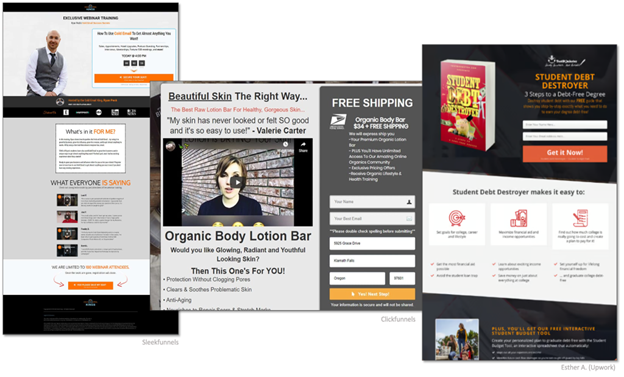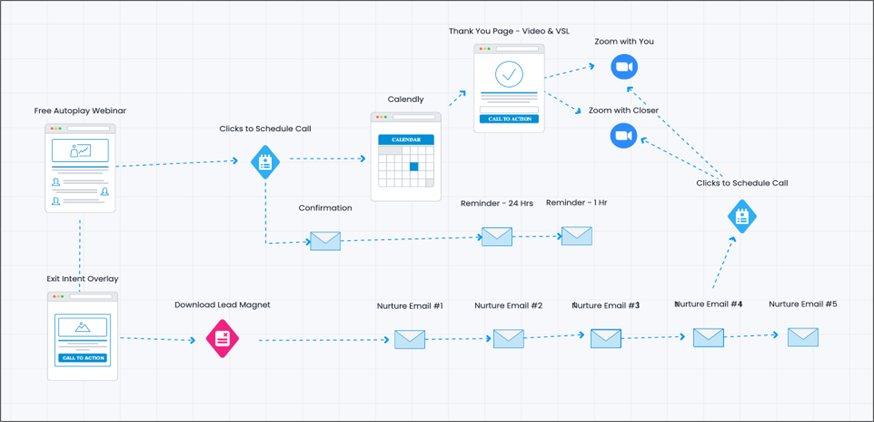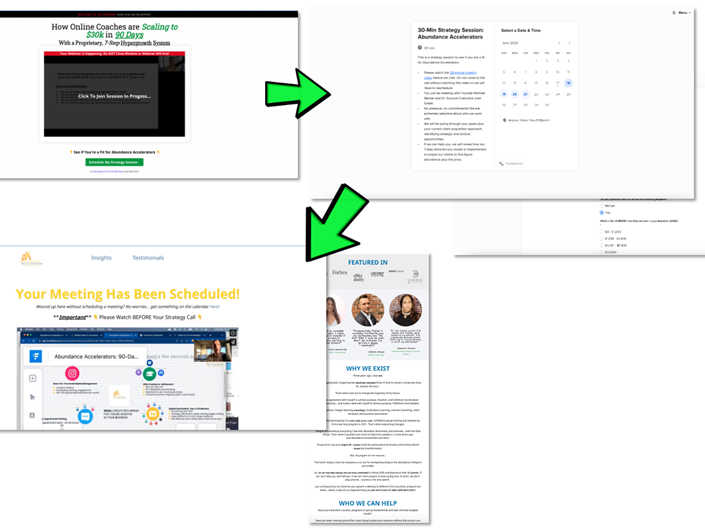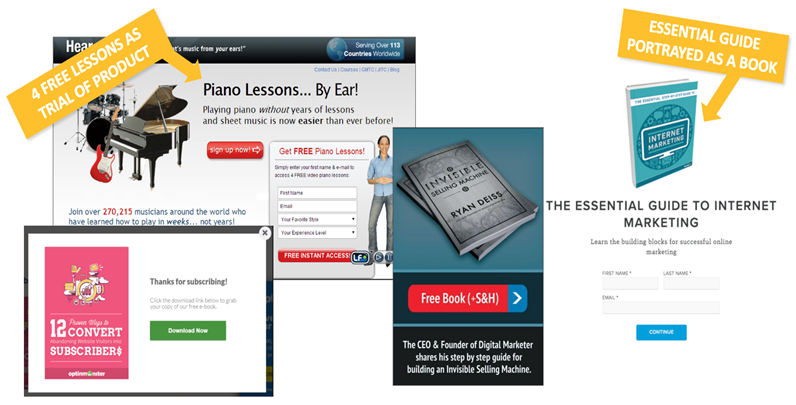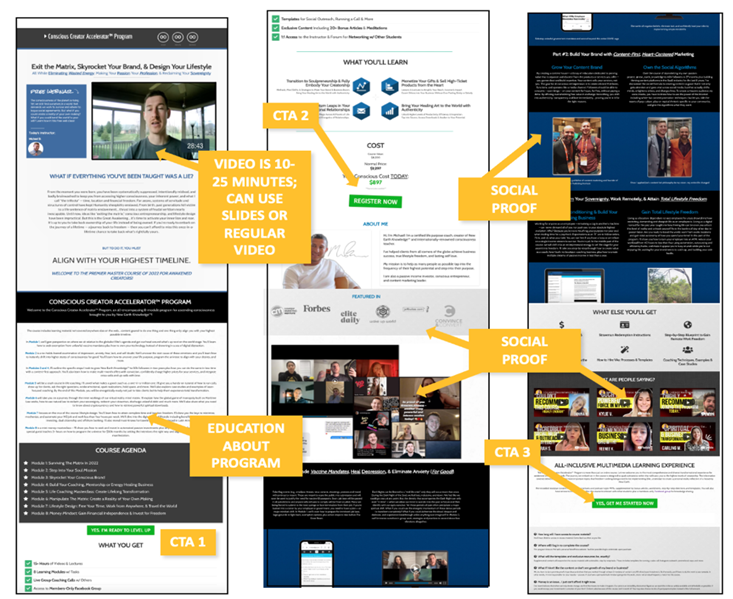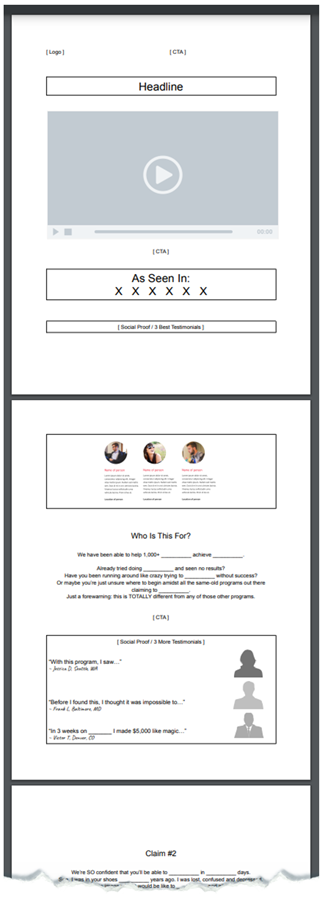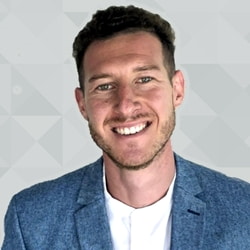When they first caught on, online lead funnels were used mainly by coaches and small businesses selling some kind of service or info product. But there's no reason enterprise brands shouldn't or couldn't get into the game.
Done right, automated lead funnels can be a key piece of your conversion engine.
In this article, I'll explain the nature of lead funnels, along with five steps to take to captivate viewers, drive conversions, and warm up qualified leads for your sales team.
What Is an Evergreen Sales Lead Funnel?
You've likely seen those ultra-sticky landing pages usually promoted via catchy social ads. Evergreen lead funnels guide prospects through a curated journey, escorting them toward a series of desired actions—maybe to grab a freebie lead magnet, buy a low-ticket front-end offer, and ultimately sign up for a call for some flagship offer.
Popularized by Russell Brunson at ClickFunnels, lead funnels can systematize multiple tactics you're already doing—e.g., paid ads, webinars, lead magnets, email, community building, and sales. That's what makes them so great.
These are the elements of an evergreen funnel I'll discuss in this article:
- Sales webinar
- Lead magnet (email capture)
- Calendar scheduler for a call
- Long video sales letter (VSL)
- Follow-up email cadence
We'll dig deeper into each in a moment.
What Is the Purpose of a Lead Funnel?
The purpose of using a funnel is to sell your offer before your team ever gets on the phone with a prospect. You're priming prospects to make it easier for your sales team to make the close when it's time. Unlike traditional sales methods, these funnels are not about push; they're all pull.
Like a great blog post, funnels should be evergreen, which means they never go out of date. They are assets that will continue to work for you, requiring only minor optimizations over time. Once you set everything up, your funnel will basically work by itself.
For my most recent e-learning course, for example, I set up my funnel like this:
- Prospects land on free autoplay webinar page.
- Email capture >>> schedule a call directly or convert on exit intent popup.
- If captured via lead magnet, contact is sent a five-touch email sequence.
- If call is scheduled, contact is redirected to Calendly, then a longform video sales letter (VSL).
- Once a call is scheduled, the contact is sent multiple confirmation emails.
- On the VSL and via email, the contact is invited to join my free community.
The real benefit of funnels is how they bridge engagement with prospect education while letting you automate the entire thing, end to end.
Here's how I mapped out the process:
Here's what the experience itself looked like:
There's a lot of nuance to each of those pieces that you'll want to be sure to get right. The success of your funnel rests upon the details. Let's go through five steps to identify what some of those details are.
A Five-Step Guide to Building Your Lead Funnel
1. Nail the conversion webinar
An automated evergreen webinar builds significant interest and demand for your offer on the spot.
Most marketers are already running webinars, but they're usually standalone events with poor follow-up. Lead funnel webinars are different in the following ways:
- They include an irresistible pitch, but only after providing tangible value first.
- They're the front-end asset of a continued, cohesive experience.
- They can be much shorter (or longer) than a standard B2B webinar.
I've adapted what Brunson has described as "the perfect webinar":
- The hook. Start by making a bold, counterintuitive claim that flies in the face of conventional wisdom. You want to create shock and awe. You want viewers saying "Wait, whaa, no... that can't really be possible... can it?!"
- The promise. Share what viewers will learn by investing their time to stick around until the end of the webinar. The reward could be a set of steps, a few actionable strategies, or a freebie.
- The story. The story is what qualifies you to share the insight that will follow. It answers the fundamental question: "Why should anyone listen to you?" The story should be personal. It should share your life-altering discovery and everything that led you to where you are now.
- Future-projecting. Paint a brief picture of a better future with a short three- or five-step plan that shows how to solve for it. Here, you'll open the door and show viewers how to begin solving their pain points, convincing them that a new future is actually possible.
- Value-stacking. After priming your audience, it's time to start encouraging them to take action. One great way to do that is value-stacking: laying out all of the benefits to moving forward versus the risks of the status quo. Make it seem as if the biggest risk of all is doing nothing. FOMO is the name of the game.
- Call to action. The last step is fulfilling your promise made at the beginning of the webinar. Do this by throwing an irresistible CTA to conclude. Depending on your approach, your CTA could be the lead magnet (with the goal of enrolling them into your nurture sequence), a sales call, or a VIP invite to a members-only community.
Top-funnel webinar pages should not contain much more content than the video itself. Distracted viewers are confused viewers.
The end goal of your webinar is to convince your prospects that taking the next step is the best thing they can do. Ultimately, the goal of the webinar is to capture their contact info.
2. Capture the email
Most people are not warm enough to buy immediately. So, it makes sense to diversify your inbound avenues with low-barrier conversion points.
That is where a freebie or low-ticket offer comes in. It's an entry point that helps you capture emails if people do not schedule a call or go for the sale.
Funnel tools should include native lead magnet functionality and allow you to create beautiful opt-in experiences.
Examples of lead magnets that you could use for your freebie:
- An e-book
- A 14-day free trial
- A bonus checklist
- A limited-time offer (LTO)
- A free mini-program
- Scripts or templates
After prospects exchange their email with you, the next step in your funnel is to redirect them to a lengthy VSL. That's where you go for the product pitch.
3. Prove value with a longform video sales letter
The point of a lengthy VSL is to either sell your product on the spot or warm up prospects so hotly that they schedule a call with you right then and there.
A VSL hooks the viewer with a mix of multimedia and informative copy. The intent is to storysell. It's your sales pitch!
A VSL also...
- Elevates your status: Immediately communicates the benefit of your offer and showcases your customers' results
- Generates conversions: Serves as a mouse trap to capture emails
- Removes objections: Addresses most questions people could have about your offer
The key to selling with a good VSL is compelling conversion copywriting. You're persuading readers as they move through the page.
A VSL should take a specific format:
[For my full VSL template, please reach out to me and I will share the PDF with you.]
Whether prospects schedule a call, convert on a download, or convert via an exit intent overlay, the next step is to auto-enroll them in a brilliant email nurture sequence.
4. Nurture with a follow-up email sequence
Once contacts have opted in, it's time to initiate your email nurture sequence.
Emails should grip recipients and pull them in with evidence that helps them understand why taking action is the only option.
Also, use the emails to retell the story you began in your webinar. Go deeper. Go wider.
You can set up your email sequence like this:
- Personal story: Go deeper into who you are as a person or company.
- Big testimonial: Use a mini case study to establish proof.
- Industry analysis: Share how your prospect's niche is changing.
- Business story: Divulge how you solved a tough situation.
- Why you're the one: Reaffirm how and why you're different.
- Scarcity or urgency. Spur action by stating your limited supply or limited-time availability.
Every email should have a CTA and should get recipients to take action on the next step in the journey: scheduling a call.
5. Set up the call
At this step, your salespeople will get involved and take over.
You're now in total attraction territory: qualified, educated prospects will be lining up to speak with you because they're already oiled up due to the other pieces of the funnel.
That's the real value of hyper-persuasive funnels: they turn the tables, giving you the leverage.
A few other tips for increasing follow-through when lining up discovery calls:
- Use a name and headshot of the adviser whom prospects will be meeting with.
- Disarm prospects by outlining a high-level agenda in the scheduler description.
- Collect only the most necessary information from prospects (2-3 fields max).
If you do it right, you should achieve a significant uptick in calls scheduled and percentage of closes with a good funnel in place.
* * *
Lead funnels have already gained mass market adoption in the services, small business, and coaching niches, but there's widespread application for them.
Lead funnels allow you to...
- Ease prospects into your offer step by step without spamming
- Engage in compliant permission-based marketing
- Create massive demand with value-additive information that prepares prospects for a "lay down" sale once they get on a call
For all those reasons, I am a huge fan of funnels. That's why I'll continue using them myself and advising my clients to do the same as they grow their businesses.
More Resources on Building a Lead Funnel
Set Up Your Lead Generation System: A Six-Step Guide [Infographic]
How to Maximize the ROI of Your Lead Generation Campaigns
Today's Digital Marketing Funnel (and How to Optimize Your Conversions)
